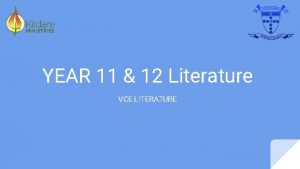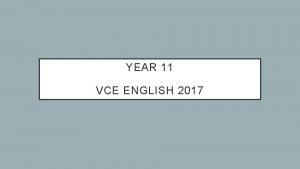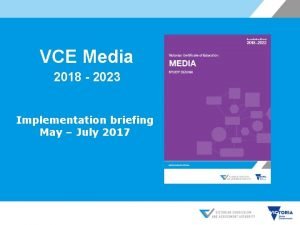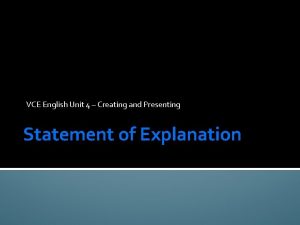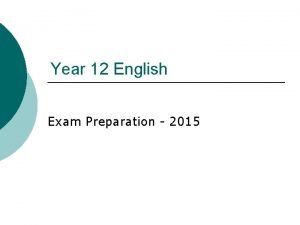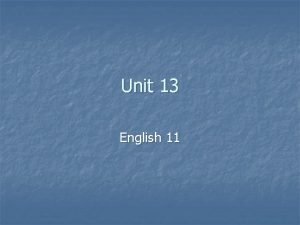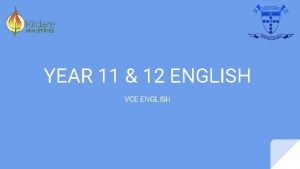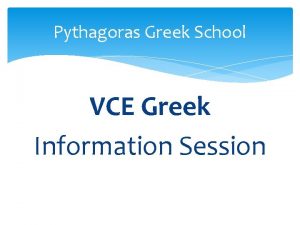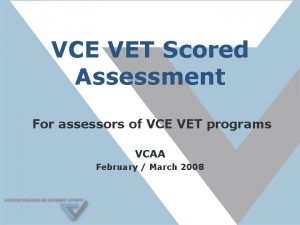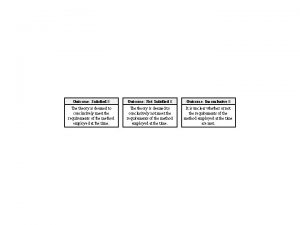Year 11 Unit 1 VCE English Outcome 1













- Slides: 13

Year 11 Unit 1 VCE English Outcome 1 (Part B): Creative Response ‘The Dressmaker’ by Rosalie Ham

So, what is the assessment task? To achieve this outcome, you will need to write a creative response to The Dressmaker. You have 2 options to choose from: 1. An ADDITION to the text to fill a silence Or 2. An ADAPTATION presenting an aspect of the story from a different perspective



I think I’d like to write an ADDITION to the text Creating an addition to the text means that you are adding something to the existing story. This addition must be within ‘the world of the text’ – consider the physical, social, cultural, ethical settings. An addition must fill a silence or gap in the text. What ‘silences’ exist in the story for you?

Ok, so what does an addition to the text look like? A prologue – this is an additional short chapter that occurs before the start of the novel. In this case, it would explore an aspect of the story before Tilly arrives in Dungatar. An epilogue – this is an additional short chapter that occurs at the end of the novel. In this case, what happens to Tilly, to Dungatar, or to its residence after Tilly leaves on the train. An internal monologue – a ‘conversation’ in one’s own mind. For example, Mad Molly or Evan Pettyman following young Myrtle’s departure; Tilly following the death of Teddy; Gertrude Pratt before or after her ‘makeover’. A letter between characters – is there something that you think was left unsaid between characters? For example, Evan and Marigold; Barney and Teddy; Molly and Tilly…?

What about an ADAPTATION of the text? Creating an adaptation of the text means that you are changing the way the reader views the story. That is, we are adapting the story to see it from a different perspective. This adaptation must be within ‘the world of the text’ – so remember to consider the physical, social, cultural, ethical settings. An adaptation must show the story from a perspective that does not exist in the original narrative. What perspectives would be interesting to explore? (e. g. an outsider or passer -by)

And what does an adaptation to the text look like? Re-write a selected scene in the novel from a different perspective – How would Tilly’s arrival back in Dungatar be explored by Sergeant Farrat? Or Evan Pettyman? How would a complete outsider/observer view the goings on of Dungatar? E. g. a reporter or a passer-by NOTE: The adaptation MUST remain within the world of the text. So no, you can not re-write a scene as a science fiction piece!

But wait, how do I stick to the Gothic Genre? The Dressmaker is considered a gothic novel. Consider the following elements of gothic literature. What examples can you find in The Dressmaker? How could you use these elements in your own creative writing piece? 1. 2. 3. 4. 5. Dreams Curses Gloomy, decaying setting Sense of mystery and dread Darkness as an intrinsic feature of humanity 6. Justice and revenge 1. 2. 3. 4. 5. 6. The pursued protagonist The outsider Death Strong moral closure Romance Madness

Where do I start? A Step-by-Step Guide 1. Decide on writing an ADDITION or ADAPTATION 2. Choose a form for your creative response. For example, prologue, epilogue etc… 3. Record all of your initial thoughts and ideas about your creative piece in a brainstorm 4. Decide on ‘voice’ – who is telling the story? This must remain consistent throughout your piece. 5. In 3 -5 dot points outline the bones of your response 6. What aspects of the ‘world of the text’ will influence your piece? Physical location, social order, cultural context, ethical/moral choices etc

Step-by-Step Guide cont… 7. Begin your draft: Set the scene – describe in detail the context to your story, including your main character/protagonist. For example, “As I sit here surrounded in chaos and destruction, my world has collapsed around me. The sharp smell of damp ash enters every crevice; a sickening reminder of what has been. The future is now unknown. My future stinks more now than it ever has…” (Trudy after Tilly leaves town) Establish the purpose of your response – what is the focus of your story/letter/epilogue etc? Create conflict and tension – as you plan your plot, make sure you explore a significant source of conflict or tension for the protagonist. This will propell the story. Build a crisis or climax – as a result of the conflict or tension above, what crisis or climax will occur? How does the character change? Detailed description of these events will be important. Deliver a resolution – this may be quite sad or dark, in keeping with the gothic genre.

Step-by-Step Guide cont… 8. Show your teacher your plan/draft in week 4– make sure you use your one opportunity to check your work with your teacher to your greatest advantage. Your teacher is able to advise you on decisions you have made but the work must remain entirely your own. 9. Edit – edit your plan and draft as many times as you can to ensure you create the best piece of writing you can **Once you have completed your final piece under exam conditions in class, use 5 -10 minutes to proof-read CAREFULLY and edit effectively. 10. Refine – make your response as perfect as possible. Consider your use of punctuation, spelling, vocabulary, grammar, sentence and paragraph structure, and connections to the world of the text.

Any questions? Concerns? Thoughts? Ideas? Good Luck!
 Vce outdoor and environmental studies
Vce outdoor and environmental studies Vce japanese kanji list
Vce japanese kanji list Vce literature
Vce literature Vce creative response
Vce creative response Vcaa 2017 english exam
Vcaa 2017 english exam Visual communication design study design
Visual communication design study design Media codes and conventions vce
Media codes and conventions vce How to write a statement of intention vce english
How to write a statement of intention vce english 2015 english exam
2015 english exam Unit 13 class 12 english
Unit 13 class 12 english Vce physics unit 1 and 2
Vce physics unit 1 and 2 Poem leaving primary school
Poem leaving primary school Si unit to english unit
Si unit to english unit Unit 6 review questions
Unit 6 review questions


